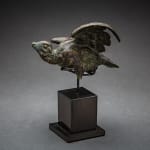Roman period bronze figurine of a bird, 300 CE - 400 CE
Bronze
12.7 x 7.6 cm
5 x 3 in
5 x 3 in
FF.092
Further images
Cast bronze alloy bird figurine, probably of votive nature, dating to the late Roman period. This unidentified bird –presumably an eaglet- is depicted with short curved beak and a rounded...
Cast bronze alloy bird figurine, probably of votive nature, dating to the late Roman period.
This unidentified bird –presumably an eaglet- is depicted with short curved beak and a rounded vivid eye visible on either sides of the head. All over the body, as well as the head, curved incisions represent the feathers whereas particular attention has been given to the wings. The fledgling is obviously shown, with great naturalism, in one of its first attempts of trying to awkwardly spread its wings. On the lower part two protruding lugs are a possible indication that the figurine was mounted on to another object.
Roman Sculpture, with artists from across a huge empire and changing public tastes over centuries, is above all else, remarkable for its sheer variety and eclectic mix. The art form blended the idealised perfection of earlier Classical Greek sculpture with a greater aspiration for realism and absorbed artistic preferences and styles from the East but also from the local Etruscan art.
As with Greek sculpture, the Romans worked stone, precious metals, glass and terracotta but favoured bronze and marble above all else for their finest work. However, as metal has always been in high demand for re-use, most of the surviving examples of Roman sculpture are in marble.
Roman sculpture did, however, begin to search for new avenues of artistic expression, moving away from its Etruscan and Greek roots, with artists seeking to capture and create optical effects of light and shade for greater realism.
This unidentified bird –presumably an eaglet- is depicted with short curved beak and a rounded vivid eye visible on either sides of the head. All over the body, as well as the head, curved incisions represent the feathers whereas particular attention has been given to the wings. The fledgling is obviously shown, with great naturalism, in one of its first attempts of trying to awkwardly spread its wings. On the lower part two protruding lugs are a possible indication that the figurine was mounted on to another object.
Roman Sculpture, with artists from across a huge empire and changing public tastes over centuries, is above all else, remarkable for its sheer variety and eclectic mix. The art form blended the idealised perfection of earlier Classical Greek sculpture with a greater aspiration for realism and absorbed artistic preferences and styles from the East but also from the local Etruscan art.
As with Greek sculpture, the Romans worked stone, precious metals, glass and terracotta but favoured bronze and marble above all else for their finest work. However, as metal has always been in high demand for re-use, most of the surviving examples of Roman sculpture are in marble.
Roman sculpture did, however, begin to search for new avenues of artistic expression, moving away from its Etruscan and Greek roots, with artists seeking to capture and create optical effects of light and shade for greater realism.







